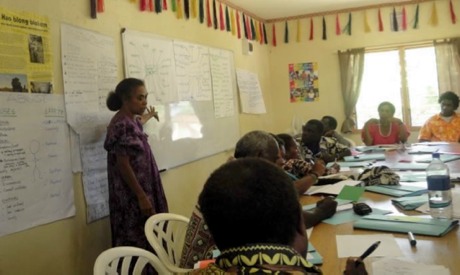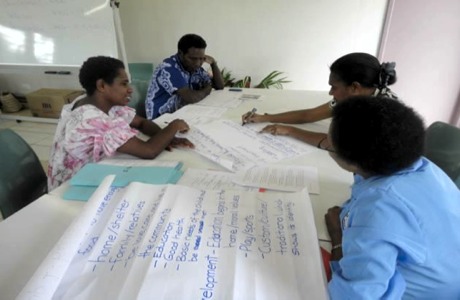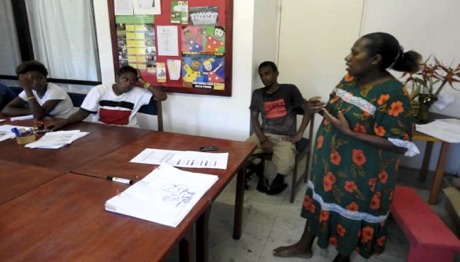In 2011, Save the Children implemented an intensive program of capacity building, training and support to deliver child protection policies for more than 2000 students in 9 schools, improving attendance and wellbeing.
A focus on behaviour change rather than just awareness-raising has meant using a wide range of engagement techniques. For example, school policies have been developed through week long workshops by the teachers themselves, so that they are contextualised and relevant. Training has focused on ongoing dialogue, with time for reflection and follow up question and answer sessions. The emphasis has been on ‘learning by doing’ through practical support, role plays, coaching and mentoring. This has been used in combination with targeted information, education and communication materials and the use of radio plays and print media.
The approach has also been multi-level – working with decision makers such as Principal Education Officers, Zonal Curriculum Advisers and Chairs of School Councils as well as the teachers and school staff.
Project successes
- 5 schools across 3 provinces (2,098 students) developed, signed off and are implementing child protection policies and codes of conduct for staff and students.
- 4 schools have policies in the process of being approved by school councils. Although in draft form, each school has al-ready made significant changes to the school environment.
- 3 schools have stopped using corporal punishment altogether.
- Feedback from students indicates they are happier and this correlates with increased attendance rates at schools.
- Over 200 teachers were trained and are receiving ongoing support with policy implementation, including follow up reflection and question and answer sessions.
- 90 teachers have signed policies and have become responsible and accountable for implementing policy.
- 50% of teachers are acting as multipliers in their communities teaching parents about positive parenting approaches and the impacts of child abuse on child development.
Despite their limited resources, teachers have generally been interested and willing to change their approaches if they are given practical support and alternative classroom management tools. They have become very motivated to reach key stakeholders and parents in the wider community with Child Protection messages.
With Save the Children’s support, National Minimum Standards in Education have been developed in partnership with the Ministry of Education. This means that from 2012 onwards, every primary school in Vanuatu will be expected to develop and implement a ‘Safe School Policy’ – including Child Protection Policy and Emergency Preparedness.
Child Protection work is being coordinated at a national level through a newly formed Child Protection Working Group, co-facilitated by Save the Children. The group builds community based child protection prevention, promotion and response systems.
Child Protection training has been undertaken in remote areas with community police. This has included victim support, identification and response to abuse, relationship building with chiefs and operating procedures for juvenile justice issues.

Photo: Elizabeth Emil, Save the Children’s Assistant Child Protection Manager in Vanuatu runs Child Protection Training with Head Teachers, Principal Education Officers and Zonal Curriculum Advisers in Tafea Province in October 2011
Challenges
The language of Child Protection is new to Vanuatu and needs to be contextualised and embedded in community values. For our work to be both effective and sustainable it has to include both individual behaviour change and institutional culture change. The time and resource investment needed to bring about this change has been significant.
Schools have tended to emphasize welfare, tackling discipline is more difficult because this has meant challenging school councils.
School councils have the power of veto in relation to school policy, corporal punishment is often enshrined within these bodies. This means that significant relationship building and advocacy with these decision makers is paramount before the work with individual schools begins.
Lack of resourcing and capacity in schools. Only 26% of teachers have had pre-service training. It was not uncommon to find teachers managing two classrooms of children simultaneously. It was important to use a problem solving approach with teachers – giving them practical advice and tools and emphasising that child protection is about keeping them safe as well and their students.
Geography. Vanuatu consists of 83 islands, many of which are very remote. Reaching the most vulnerable communities is difficult, time consuming and expensive. Save the Children’s newly recruited island teams offer an opportunity to address this in the future – see ‘What Next’ below.
Variance from original project design:
A decision was taken early in the project to include Tafea as a third province in response to evidence of great need, direct requests for help from head teachers and the existence of a supportive network of community and provincial government contacts. Initially the team worked with 10 schools, however one school council vetoed the policy in its early development stages because of their commitment to corporal punishment. Whilst we continue to engage in dialogue with this school, a decision was taken to invest more heavily in the remaining nine cooperative schools.

Photo: Teachers from Shefa Province attend a Save the Children follow up reflection workshop in October 2011.
Quotes from schools following the Child Protection training program:
“I have learned how to identify the signs in the children who have been abused and what to do about it.”
Teacher from Malapoa College
“This has really changed my perspective. I realised that I have failed as a teacher, a father at home. My behaviour and attitudes towards children are too harsh. I need to change the way I treat them”
Teacher from Onesua School
“Now I know how to handle some of my failures in both school and home. I hope I can improve on some of my weaknesses, thank you.”
Teacher from Kamewa School
“In my work place, I will take time to discuss and share the knowledge with my students and understand in special cases it needs discussion and agreement between teacher and students. In the community I realised that there is a great need for this knowledge to be passed onto especially parents and the youth and children who will be the leaders of tomorrow.”
Teacher from Sarakata School
“I have learnt a lot of information on how I can improve myself in protecting a child either at school, at home, on the street or elsewhere.”
Teacher from Sarakata School
“I enjoyed discussing the duty of care. This is because I need to know how to handle the situation especially with the different types of abuses they have. So that they are always safe.”
Teacher from Matevulu College
“I especially enjoyed the discussions when questions were raised, dealing with real situations. It is very interesting to find out how we will deal/respond to such situations and cases. And risk management, we all know what the risk is after talking about the Policy.”
Teacher from Matevulu College

Photo: Annie Benua, Child Protection Officer – runs a workshop with chil- dren and young people to pre-test Child Protection education materials in Shefa Province, March 2011.
What's next for this project?
Significant change and momentum has been generated by the Child Protection project, and we would like to capitalise on this and build on what we have learned. In addition to continuing to support the schools with the finalisation and implementation of their policy, we would also like to focus on the following new areas:
Using highly motivated individuals as Child Protection champions – participating in newly formed and community based Child Protection Working Groups that are developing community based child protection systems that strengthen
links between the Kastom and formal support networks. This follows an integrated program approach that builds networks with health workers and women’s centres.
Save the Children has been supporting the Ministry of Education to develop Minimum Standards for all primary schools that includes a Safe School Policy – that includes Child Protection, school safety, non-discrimination and Disaster Preparedness. As a result we have an opportunity to reach many more schools, by feeding into the development of a national framework and implementation strategy and at a community level continuing to invest in ‘model schools’ that can represent best practice examples for other schools to learn from and replicate.
Increasing participation by the students themselves. In Vanuatu, children traditionally learn by watching and generally their active or vocal participation is not encouraged. In the ‘model schools’ we want to show that involving children is good for everyone. By getting student representatives on school decision making bodies and setting up peer support student groups to support bullying.
Developing practical Child Protection modules that reflect community based approaches for pre-service teacher and kindergarten training and curriculum development and preservice training for health workers and police officers.
Reaching the most remote communities. Save the Children has recently recruited five island based teams, that could be intensively trained in Child Protection prevention, promotion and response.
Funds raised for this project will be used to develop child specific school based resources on different abuses (physical, emotional, sexual, neglect), and to train teachers on child protection.
Objectives and Outcomes
The project aims to strengthen the child protection systems in Vanuatu to ensure that children are safe from all forms of abuse. The goals are:
- To develop and deliver child protection resources, training programs and awareness raising activities for 10 schools and target communities within Efate and Santo provinces
- To facilitate and promote the development of child protection policies in 10 target schools in partnership with the Ministry of Education and UNICEF
- To develop and deliver strategies which will advocate for the end of corporal punishment in schools.
Background
The extended family is the basic social unit in Vanuatu and acts as the safety net that protects and caters for the needs of its members, including children. Due to the rapid social change experienced in recent years, this protective family system is being threatened and slowly weakened. As a result, children are often left vulnerable to maltreatment and inadequate protection from exploitation. There has been an increase in substance abuse and sexual exploitation among children. Family units, community leaders, religious leaders, young people and children still lack understanding of child rights and child protection. Knowledge of child protection in schools, both by teachers and students is low. A UNICEF child protection survey showed bullying is common in schools.
There have been limited substantive gains in child protection systems and government capacity within Vanuatu in recent years. This project is a stand-alone initiative from Save the Children which also contributes directly to the Vanuatu Government’s multi-year (2011-2012) child protection work plan and supports the broader Save the Children International’s priorities of strengthening national child protection systems.
Partnerships
The key implementing government partners include; the Ministry of Social Welfare, Ministry of Internal Affairs, Ministry of Education and Ministry of Health. Save the Children is a long term partner of both UNICEF and the Vanuatu government and this project will fall under a small scale funding agreement between these parties.